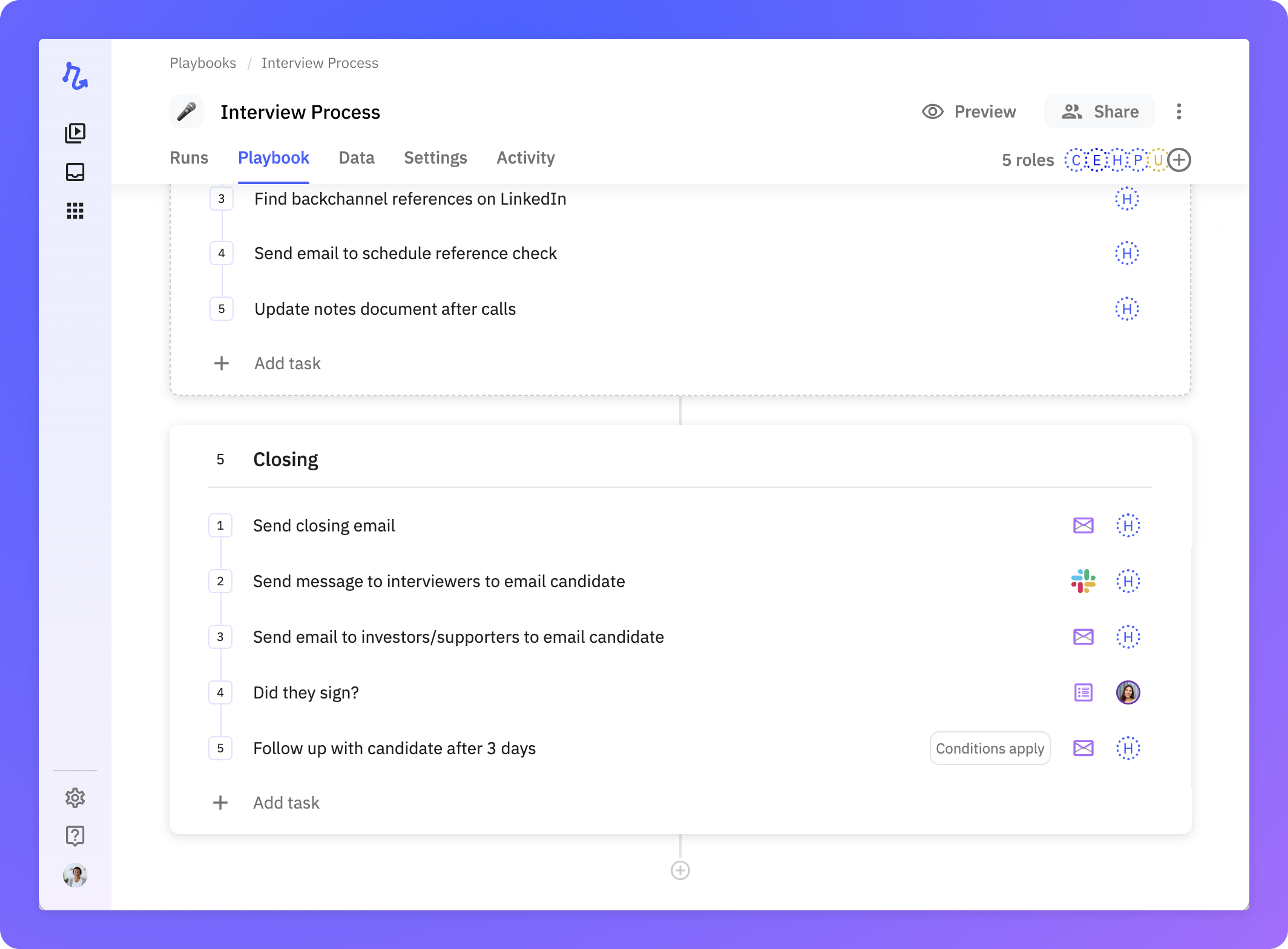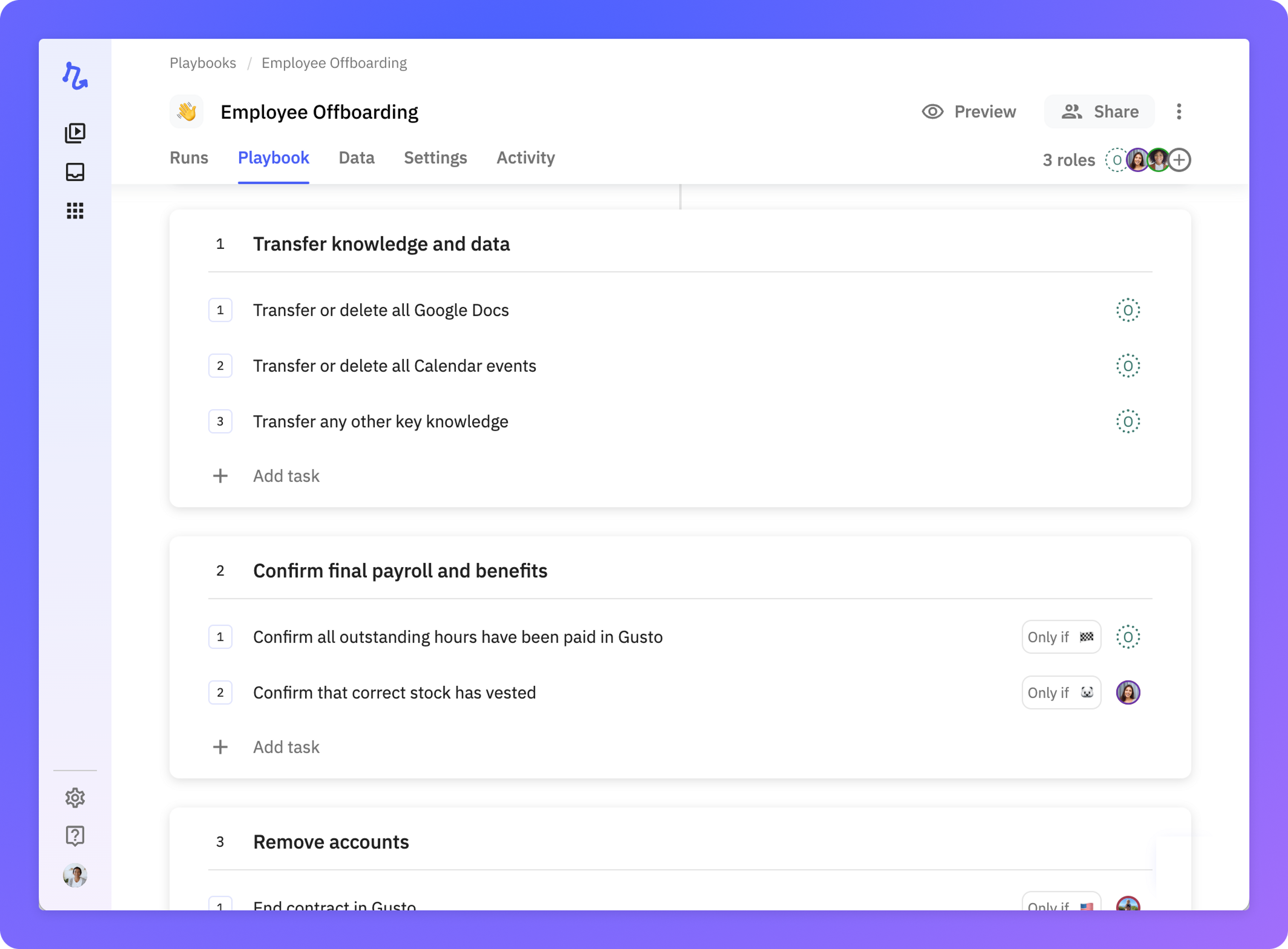I made a ton of mistakes as a first time founder. I was 23 years old and had no idea how to grow and manage a team. I forgot to follow up with candidates, took too long to schedule interviews, didn’t push hard enough to close, and much more.
I’ve learned a lot since then, both through leading large teams at Google and now working on my second startup, and I’ve gotten much better at two things:
- Structuring our repeated playbooks.
- Automating as much as possible. Side note: We’re building Relay–a collaborative workflow automation tool–specifically to do this!
This post shows a few simple best practices for candidate outreach, interviewing, onboarding, and more. They’ve saved me a ton of time and hassle, and I hope they’ll do the same for you!
📬 Candidate Outreach
Do you have dozens of awesome candidates begging to join your company? If so, awesome! If not, you’re going to need to put a lot of effort into outreach. While it seems simple to just find a candidate and message them, it’s a lot of work to do it right. Here are a few tips:
- Use a tracker: If you’re like me, you’ll make silly mistakes like emailing the same person twice or forgetting to follow up when you said you would. Keep a simple tracker, like this one that we use at Relay.
- Write outreach scripts: Don’t reinvent the wheel every time you need to reach out to a candidate. Make a general script with a few variants of your outreach message, and structure it in a way that is adaptable for the specific candidate and role. Here’s an example of our outreach message template for Relay.
- Set a target and stick to it: Make sure you have a crisp goal of how many candidates you will reach out to each week and (a) block 2 hours on your calendar for each week for each role you’re hiring for and (b) include your progress in a weekly status update the team (here’s a little template).

Check out our use case page for more detailed information on how to use Relay for candidate outreach, or get started with the Relay template directly!
☎️ Interviewing Candidates
Next up, you have to interview candidates. Again, it seems simple to hop on Zoom, conduct the interview, and make a decision. But there’s a ton of coordination behind the scenes to run an efficient process with a good candidate experience. Here are a few tips to streamline and improve your process:
- Have a shared notes doc for the team. When I first started interviewing candidates, we were inefficient and ineffective because we didn’t have a notetaking system. The simple solution of creating a templated, shared document for the interview team was all we needed. Here’s an example of a notes template that we use at Relay.
- Set up interviews fast. Moving your hiring process along quickly is key for the candidate and company. Connect the interview team to the candidate right away, using a simple template like this one to make introductions as soon as you know who the interviewers are.
- Follow up with the candidate–immediately. Follow up with the candidate as soon as you can about next steps, ideally within hours after their interview. Create templates like these for moving forward or politely rejecting the candidate.

Check out our use case page for more detailed information on how to use Relay for interviewing candidates, or get started with the Relay template directly!
✍️ Closing Candidates
You’ve sourced the candidate, you’ve gone through the entire interview process, and you’ve given the offer. So you’re done! I used to think that, but I’ve realized now you’re far from being done, and this is actually one of the most crucial phases. Here are some best practices I’ve learned about closing candidates:
- Have team members, investors, and mutual contacts send encouragement. The more touch points with your candidate, the better. Leverage the power of your entire team to send encouragement to join; here’s what these comms can look like.
- Help get their family excited about the opportunity. Family and partners play a key role in deciding whether a startup is the right fit. Ask for an introduction to meet with them directly about their questions and concerns using a template like this one.
- Act as if you are working together already. As soon as you make the offer, share progress updates, loop them into documents, invite them to meetings, and treat them as if they’re already part of the team.

Check out our use case page for more detailed information on how to use Relay for closing candidates, or get started with the Relay template for interviewing candidates, which includes a section on closing candidates, directly!
🎉 Onboarding Team Members
A new team member – exciting! But now comes the tedious process of setting up their email, getting them a laptop, connecting them to all of the systems they’ll need, making sure their payroll information is in place, and more – this can be as many as 50 steps for each employee! Here are some tips to get this process right, every time:
- Have a system for completing paperwork and providing account access. There are a lot of steps to onboard each employee, so keeping a list or process for remembering and doing each is key. Here’s the checklist we use for Relay onboarding.
- Make sure they are in the right meetings and communication channels. Ensuring new employees are in the loop from day one is super important, so keep a clear process for what channels and meetings they need to be added to. Here’s ours.
- Personalize their getting started guide and over communicate everything. There’s no need to reinvent the wheel with a new onboarding doc for every employee. Use a template as a starting point and then customize it for each employee. Here’s an example of the onboarding doc we use.

Check out our use case page for more detailed information on how to use Relay for employee onboarding, or get started with the Relay template directly!
👋 Offboarding Team Members
Sometimes team members need to move on to new things. It’s important to handle all of the logistics to ensure the transition goes smoothly. But each time the day comes around, it’s hard to remember exactly what all of those offboarding steps are and to complete them in a timely manner. Here are some key steps we’ve decided are worth doing in the offboarding process:
- Have the employee transfer ownership of all documents and events. Save yourself the headache later and while the employee is still onboard, ensure they pass off all key resources to a new owner.
- Review and change access levels to all tools. Create a list of all of the systems you need to change access levels to. Then go through each and change permission levels, remove accounts, or take any other required action. Here’s a sample list.
- Conduct an exit interview. This is an incredibly valuable opportunity to both review ways the company can operate better and cover any final logistics (COBRA health insurance, option purchasing, final paycheck, etc). Here’s a script from ours.

Check out our use case page for more detailed information on how to use Relay for offboarding employees, or get started with the Relay template directly!
